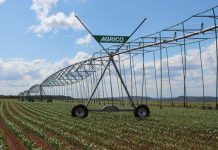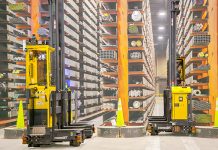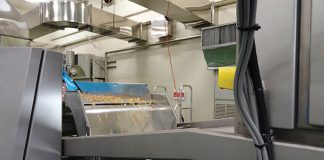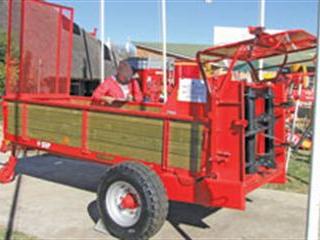
This year’s Nampo Harvest Day showcased a wide variety of implements from around the world:
The SIP Orion 35R manure spreader comes from Slovenia and enables a farmer with a tractor as small as 15kW to mechanise his muck spreading. A wide wheel track and low centre of gravity mean it’s safe on steep hillsides. Imported by Staalmeester.
From Italy, and imported by Staalmeester, the Enorossi BFS 165H sickle bar mower can also be operated by a 15kW tractor. The double knife design enables fast mowing. Cutting width is 1,65m, and the cutting gear is lifted hydraulically.
The 5000 series Great Plains Turbo-Chisel from the US can operate up to 300mm deep and can chop and incorporate residue in the top 130mm of the soil. The chopper reels are designed so that the blades are in constant contact, reducing vibration and maximising cutting action. They work perpendicular to the turbo coulters leaving a smooth seedbed for the planter.
The Canadian-built Andersen in line bale wrapper apparently uses up to 40% less plastic film than conventional wrappers and the work rate is 120 bales per hour. Along with the Great Plains equipment, it’s imported by Agri Afrika.
India’s FieldKing range is marketed in SA by GMG Power. The 3-furrow mouldboard plough can be used in stony soils, while the bar-points can be extended or reversed and re-used down to the smallest possible length. The 10×10 model with twenty 560mm boron steel discs and a cutting width of 2,275m is the largest in the five model offset disc harrow range. Smallest is the 6×6 at 1,375m.
Another addition to the Machio-Gaspardo range manufactured in Italy and marketed in SA by New Holland is the PTO driven, mounted 2-row potato lifter.
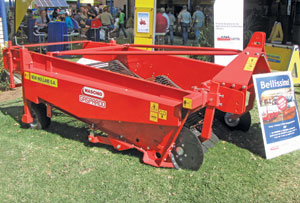
The Maschio Gaspardo MPD 165 2-row potato lifter.
Hitch conversion for baler
Gert Davis of Mnani Implements says his drawbar conversion for the Chinese-made Tuffy Mini-Baler is a great improvement. The baler follows the tractor through bends and turns and is safer and easier to operate than with the original three-point mount attachment. The driver also has a clear view of the pick-up reel.
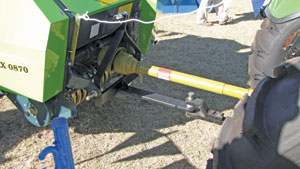
The Mnani hitc for the Tuffy RX 0870 Mini-Baler
Imports from Intrac Trading
The Strautman silage fork (Germany): Strautmann supplies a range of shear grabs suitable for various sizes of tractor front-end loaders. Two heavy-duty double-acting hydraulic cylinders push the cutting frame through the silage. A block of silage is cut out cleanly, reducing spoilage and allowing a high loading speed into mixers or feeder wagons.
The Comeb multi-row cultivator (Italy): These multi-row cultivation and strip tillage machines work efficiently in all row crop applications in raised beds or full land crops. They can be calibrated to weed the smallest of seedlings. Weeding and fertilising can be done in one pass.

The Comeb multi-row cultivator.
The Knapik single row ‘no-till’ planter (Brazil):Brazil is acknowledged as one of the world leaders in the move to conservation agriculture. This unit can plant maize, sorghum, soya beans, sunflower and so on, and no tools are required for adjustments.
The 12×22 Buffalo mounted offset disc (China): The smallest of the Buffalo range of offset disc harrows is suitable for light tractors from about 15kW. It’s a mounted unit with 12 x 560mm discs and a cutting width of 1,2m. The range goes up to a 28-disc trailed model.
The Robertson Super Combi hay, silage and grain feeder
This versatile machine from New Zealand can feed all types and sizes of round and square bales, including hay, straw and silage, which can be loaded with the self-loading forks and moved into place by the hydraulic floor conveyor. The Super Combi can also feed finely chopped silage and has a level load capacity of 9,6m³. It’s distributed by Kouga Implements.
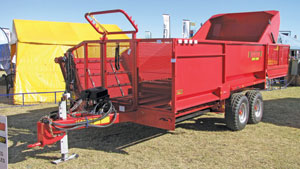
The Robertson Super Combi hay, silage and grain feeder.
The Bronto E250 extruder
In ‘extrusion’, material is pushed through a restricted outlet in order to change its characteristics. In the process, used to extrude animal feeds such as maize or soya beans, a series of flights rotating at speed cause structural change in the material. The temperature increases as a result of mechanical shearing, friction and the creation of steam. Extrusion makes the product easier to digest and the high temperature (about 150°C) kills bacteria and strilises the product.
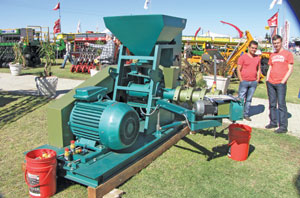
Made in the Ukraine: the Bronto E250 extruder.
The high temperature also breaks down the trypsin inhibitors found in raw soya beans, creating a high protein, high energy feed for cattle and poultry. The Bronto E250 from the Ukraine has a 37kW electric motor, and can extrude 250kg of soya beans an hour. It is distributed by Valtrac.
The ultimate off-roader
The Mercedes Benz Unimog’s exceptional off-road capability is due to many features, such as the flexible ladder-type frame, all-wheel drive with differential locks on both axles and ‘tyre control’ tyre pressure control system.
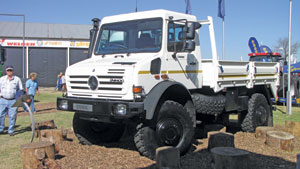
The mighty Unimog U5000.
Agri-Spread fertiliser and lime spreaders
Made in Ireland, Agri-Spread spreaders can handle a wide range of materials including lime, fertiliser and poultry manure. Hydraulic control of the spinner and drop point adjustment ensures accurate spreading up to 24m, depending on the material. The AS120 has a capacity of 12t fertiliser or 14t lime. Jupidex is the SA distributor.
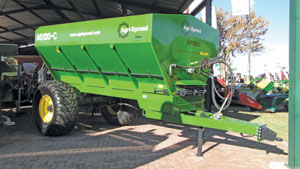
The Agri-Spread AS120-C.
The Manitou silage cutter attachment
This hydraulically powered rotating cutting cylinder from France quickly opens up the face of a silage clamp, leaving the cut material ready for cattle to feed or for the telehandler to load into a feeder wagon. The clean cut made by the cylinder helps prevent spoilage.
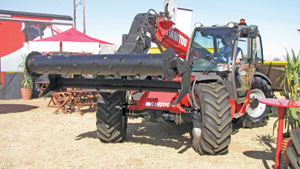
The Manitou silage cutter attachment mounted on an MLT735 LSU Turbo telehandler.




